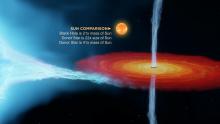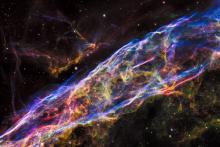Listen to today's episode of StarDate on the web the same day it airs in high-quality streaming audio without any extra ads or announcements. Choose a $8 one-month pass, or listen every day for a year for just $30.
You are here
Cygnus Superbubble
The swan soars high overhead on late-summer nights. It’s high in the east at nightfall, with its body roughly parallel to the horizon, and its graceful wings extending above and below. Its brightest star, Deneb, marks the swan’s tail.
If your eyes were sensitive to X-rays, you’d see a giant horseshoe looping around Cygnus. That’s the Cygnus Superbubble, a cloud of hot gas that spans perhaps 1500 light-years. It may have formed from the explosion of a monster star.
The superbubble lies along one of the galaxy’s spiral arms. So when astronomers look at it, they’re looking into a region that’s full of bubbles, clouds, and other structures. That’s made it hard for them to figure out the bubble’s nature.
Over the years, they’ve come up with several possible explanations. One is powerful winds from hundreds of massive young stars. Another is the explosions of dozens of such stars.
In recent years, though, they’ve started to zero in on another explanation: a hypernova — a blast far more powerful than a supernova. The shockwave would clear out gas and dust far away from the star — forming a superbubble.
The shockwave also would create X-rays — like those seen from the Cygnus Superbubble. And it would create cosmic rays — particles accelerated to almost the speed of light — which also come from the superbubble.
So a giant bubble around the swan may have formed in one of the most powerful explosions in the universe.
Script by Damond Benningfield





